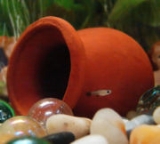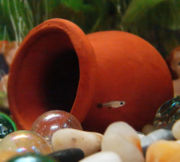
Poeciliidae
Encyclopedia
Poeciliidae is a family of fresh-water fish
which are live-bearing aquarium fish
(they give birth to live young). They belong to the order Cyprinodontiformes
, tooth-carps, and include well-known aquarium fish such as the guppy
, molly
, platy
, and swordtail. The original distribution of the family was the southeastern United States
to north of Rio de la Plata, Argentina
, and central and southern Africa
, including Madagascar
. However, due to release of aquarium specimens and the widespread use of species of the genera Poecilia
and Gambusia
for mosquito control, poeciliids can today be found in all tropical and subtropical areas of the world.
species, which have internal fertilization and the eggs hatch before being laid, so the female gives birth to live young. All African species are egg-layers, and (with the exception of the members of the genus Tomeurus) all American species are live-bearers. This distribution suggests Poeciliidae antedate the split between Africa and South America 100 million years ago, and live-bearing subsequently evolved in South America. Poeciliids colonized North America through the Antilles while they were connected 44 million years ago. Poeciliids then moved to Central America by the Aves land bridge. When South America reconnected to Central America 3 million years ago, there was some dispersal southward, but South American species did not move into Central America.
Among the live-bearing species, differences in the mode and degree of support the female gives the developing larvae occur. Many members of the family Poeciliidae are considered to be lecithotrophic (the mother provisions the oocyte
with all the resources it needs prior to fertilization, so the egg is independent of the mother), but others are matrotrophic
(literally means "mother feeding": the mother provides the majority of resources to the developing offspring after fertilization).
Members of the genus Poeciliopsis
, for example, show variable reproductive life history adaptations. Poeciliopsis monacha
, P. lucida, and P. prolifica form part of the same clade within the genus Poeciliopsis. However, their modes of maternal provisioning vary greatly. P. monacha can be considered to be lecithotrophic because it does not really provide any resources for its offspring after fertilization - the pregnant female is basically a swimming egg sac. P. lucida shows an intermediate level of matrotrophy
, meaning that to a certain extent the offspring's metabolism can actually affect the mother's metabolism, allowing for increased nutrient exchange. P. prolifica is considered to be highly matrotrophic, and almost all of the nutrients and materials needed for fetal development are supplied to the oocyte
after it has been fertilized. This level of matrotrophy allows Poeciliopsis to carry several broods at different stages of development, a phenomenon known as superfetation
. Because the space for developing embryos is limited, viviparity reduces brood size. Superfetation can compensate for this loss by keeping embryos at various stages and sizes during development.
Poeciliopsis elongata, P. turneri and P. presidionis form another clade which could be considered an outgroup to the P. monacha/P.lucida/P.prolifica clade. These three species are very highly matrotrophic - so much so that in 1947, C. L. Turner described the follicular cells of P. turneri as "pseudo-placenta, pseudo-chorion, and pseudo-allantois".

Fish
Fish are a paraphyletic group of organisms that consist of all gill-bearing aquatic vertebrate animals that lack limbs with digits. Included in this definition are the living hagfish, lampreys, and cartilaginous and bony fish, as well as various extinct related groups...
which are live-bearing aquarium fish
Live-bearing aquarium fish
Live-bearing aquarium fish, often simply called livebearers, are fish that retain the eggs inside the body and give birth to live, free-swimming young.-Common aquarium livebearers:...
(they give birth to live young). They belong to the order Cyprinodontiformes
Cyprinodontiformes
The Cyprinodontiformes is an order of ray-finned fish, comprising mostly small, fresh-water fish. Many popular aquarium fish, such as killifish and live-bearers, are included. They are closely related to the Atheriniformes and are occasionally included with them...
, tooth-carps, and include well-known aquarium fish such as the guppy
Guppy
The guppy , also known as the millionfish, is one of the most popular freshwater aquarium fish species in the world. It is a small member of the Poeciliidae family [females long, males long] and like all other members of the family, is live-bearing....
, molly
Poecilia
Poecilia is a genus of euryhaline brackish water fish in family Poeciliidae of order Cyprinodontiformes. The type species is P. vivipara. Live-bearers, the Poecilia species are collectively known as mollies, with the exception of Endler's livebearer and the famous guppy...
, platy
Xiphophorus
Xiphophorus is a genus of euryhaline and freshwater fishes in the family Poeciliidae of order Cyprinodontiformes. The many Xiphophorus species are all called either platyfish or swordtails. The type species is X. hellerii, the Green swordtail. Platyfish and swordtails are Live-bearers, meaning...
, and swordtail. The original distribution of the family was the southeastern United States
United States
The United States of America is a federal constitutional republic comprising fifty states and a federal district...
to north of Rio de la Plata, Argentina
Argentina
Argentina , officially the Argentine Republic , is the second largest country in South America by land area, after Brazil. It is constituted as a federation of 23 provinces and an autonomous city, Buenos Aires...
, and central and southern Africa
Africa
Africa is the world's second largest and second most populous continent, after Asia. At about 30.2 million km² including adjacent islands, it covers 6% of the Earth's total surface area and 20.4% of the total land area...
, including Madagascar
Madagascar
The Republic of Madagascar is an island country located in the Indian Ocean off the southeastern coast of Africa...
. However, due to release of aquarium specimens and the widespread use of species of the genera Poecilia
Poecilia
Poecilia is a genus of euryhaline brackish water fish in family Poeciliidae of order Cyprinodontiformes. The type species is P. vivipara. Live-bearers, the Poecilia species are collectively known as mollies, with the exception of Endler's livebearer and the famous guppy...
and Gambusia
Gambusia
Gambusia is a large genus of fish in family Poeciliidae . Gambusia contains over 40 species, most of which are principally found in freshwater habitats, though some species may also be found in brackish or saltwater habitats. The type species is the Cuban gambusia, Gambusia punctata)...
for mosquito control, poeciliids can today be found in all tropical and subtropical areas of the world.
Live-bearing
Although the whole family Poeciliidae is known as "live bearers", there are egg-scattering species with external fertilization in addition to the true live-bearing viviparous and ovoviviparousOvoviviparity
Ovoviviparity, ovovivipary, or ovivipary, is a mode of reproduction in animals in which embryos develop inside eggs that are retained within the mother's body until they are ready to hatch...
species, which have internal fertilization and the eggs hatch before being laid, so the female gives birth to live young. All African species are egg-layers, and (with the exception of the members of the genus Tomeurus) all American species are live-bearers. This distribution suggests Poeciliidae antedate the split between Africa and South America 100 million years ago, and live-bearing subsequently evolved in South America. Poeciliids colonized North America through the Antilles while they were connected 44 million years ago. Poeciliids then moved to Central America by the Aves land bridge. When South America reconnected to Central America 3 million years ago, there was some dispersal southward, but South American species did not move into Central America.
Among the live-bearing species, differences in the mode and degree of support the female gives the developing larvae occur. Many members of the family Poeciliidae are considered to be lecithotrophic (the mother provisions the oocyte
Oocyte
An oocyte, ovocyte, or rarely ocyte, is a female gametocyte or germ cell involved in reproduction. In other words, it is an immature ovum, or egg cell. An oocyte is produced in the ovary during female gametogenesis. The female germ cells produce a primordial germ cell which undergoes a mitotic...
with all the resources it needs prior to fertilization, so the egg is independent of the mother), but others are matrotrophic
Matrotrophy
Matrotrophy is a form of development in which the embryo is supplied with additional nutrition from the mother . This can be contrasted with lecithotrophy, in which the only source of nutrition for the embryo is yolk originally contained within its egg.In plant sciences, matrotrophy is considered...
(literally means "mother feeding": the mother provides the majority of resources to the developing offspring after fertilization).
Members of the genus Poeciliopsis
Poeciliopsis
Poeciliopsis is a genus of fish in the Poeciliidae family.Species include:* Poeciliopsis infans – Lerma Livebearer* Poeciliopsis monacha* Poeciliopsis occidentalis – charalito...
, for example, show variable reproductive life history adaptations. Poeciliopsis monacha
Poeciliopsis monacha
Poeciliopsis monacha is a species of fish in the Poeciliidae family. It is endemic to Mexico.-Source:* Contreras-Balderas, S. & Almada-Villela, P. 1996. . Downloaded on 4 August 2007....
, P. lucida, and P. prolifica form part of the same clade within the genus Poeciliopsis. However, their modes of maternal provisioning vary greatly. P. monacha can be considered to be lecithotrophic because it does not really provide any resources for its offspring after fertilization - the pregnant female is basically a swimming egg sac. P. lucida shows an intermediate level of matrotrophy
Matrotrophy
Matrotrophy is a form of development in which the embryo is supplied with additional nutrition from the mother . This can be contrasted with lecithotrophy, in which the only source of nutrition for the embryo is yolk originally contained within its egg.In plant sciences, matrotrophy is considered...
, meaning that to a certain extent the offspring's metabolism can actually affect the mother's metabolism, allowing for increased nutrient exchange. P. prolifica is considered to be highly matrotrophic, and almost all of the nutrients and materials needed for fetal development are supplied to the oocyte
Oocyte
An oocyte, ovocyte, or rarely ocyte, is a female gametocyte or germ cell involved in reproduction. In other words, it is an immature ovum, or egg cell. An oocyte is produced in the ovary during female gametogenesis. The female germ cells produce a primordial germ cell which undergoes a mitotic...
after it has been fertilized. This level of matrotrophy allows Poeciliopsis to carry several broods at different stages of development, a phenomenon known as superfetation
Superfetation
Superfetation is the simultaneous occurrence of more than one stage of developing embryo in the same animal. In mammals it manifests as the formation of a fetus from a different menstrual cycle while another embryo is already present in the uterus...
. Because the space for developing embryos is limited, viviparity reduces brood size. Superfetation can compensate for this loss by keeping embryos at various stages and sizes during development.
Poeciliopsis elongata, P. turneri and P. presidionis form another clade which could be considered an outgroup to the P. monacha/P.lucida/P.prolifica clade. These three species are very highly matrotrophic - so much so that in 1947, C. L. Turner described the follicular cells of P. turneri as "pseudo-placenta, pseudo-chorion, and pseudo-allantois".


